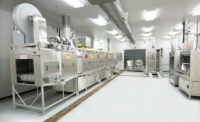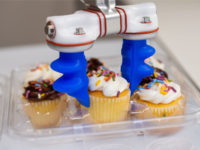Companies that make pans for the baking industry—whether for breads, baguettes, muffins, cookies, cakes, pies, etc.—are focused on issues like larger sizes, a desire for energy and material efficiency, stick resistance, and the ability to help produce specialty and artisanal products.
Their counterparts that create pan release agents are trying to make sure that their products are less noxious to the working environment and do not end up damaging the pans in the process. Those making pan washers are improving their products on a range of fronts, from more sanitary design to greater versatility.
Pan advantages
American Pan, a Bundy Baking Solution, Urbana, OH, has noticed a significant increase in the size of baking pans, primarily in the bun and roll market, according to Jason Tingley, vice president. Focused on energy efficient pans for larger bakery systems, American Pan has been developing larger sizes that offer thermal efficiency and bakery throughput, he says.
“Pan sizes today are commonly two to three times larger than what would be called ‘traditional size’ commercial pans,” Tingley says. “We have engineered new designs and incorporated new materials into these larger pans to maintain or increase the integrity of the pans. For instance, we’ve integrated tubular frames, high-strength materials, and geometrical wire shapes.”
Another area of focus for bakeries that brings about energy and material efficiency is the ability to easily replace screens/and or panels on the pans, which American Pan has addressed through the TabLock baking tray design, says Tingley. By giving bakeries the ability to reuse their current stainless-steel tray frames multiple times, the TabLock saves time, material expense, and freight.
“American Pan offers the service of replacing tray screens at our facility, or we can supply the required tools and support so that our customers can do it at their own facility,” Tingley says. “As a result, bakeries only need to replace specific screens that are damaged or have reached the end of their coating life.”
Sasa Demarle, Cranbury, NJ, has noticed trends in the demand for pans that help produce artisan-style and specialty breads with seeds, cereals, or grains, or those that are gluten-free. Another area of focus is the premiumization of bread and related products, says Brandon Iacometta, marketing manager, North America.
People are going away from making tons of low-quality products and trying to focus on the quality, artisan-style products, where they can make more of a margin, says Iacometta. “With that comes obvious challenges, one of them is getting the quality with high-speed production. We’ve seen a change in the manufacturing process.”
Sasa Demarle comes into this picture with innovations in non-stick coatings, with trays adapted to meet projects that require clean labels, Iacometta says. “It’s a collaboration between us and the customer: ‘Here’s what you’re trying to make, here’s how we can help achieve these things effectively, and cost efficiently,’ ” he says. “We have to understand the entire process, from producing the dough, and proofing the dough, all the way up to baking it, until you’re putting it up on shelves and in boxes.”
Another significant issue is traceability and quality control of baking trays, which has prompted Sasa Demarle to put in place systems in place to track the conveyors in the trays and on the lines, Iacometta says. “Gluten-free needs to be separated and kept away from other, standard products,” he says. “Another improvement has been high-resistance coating, focusing on high temperatures and a higher number of cycles,” typically used for bread but also cinnamon rolls, croissants, buns, and pretzels.
LloydPans, Spokane, WA, focuses on small to midsized bakeries and offers both light and dark aluminum pans used most often for cheesecake, angel food cake and pizza, says Robert Johnson, marketing manager. Breads, pie crusts and other products that require browning go in hotter-baking dark pans, while more-delicate products go in lighter pans. The light-colored pans have a permanent release coating that lasts through countless baking cycles, he says. “It’s also stick resistant—customers completely eliminate parchment paper.”
LloydPans products are steam-proof, eco-friendly, and recyclable, with a water-based coating, and no toxic petrochemicals, and a scratch resistant finish, Johnson says. “You can scrape across the surface with metal spatulas, endlessly,” he says. “At a trade show, we take a nickel and scrape as hard as we can. The nickel wears off on the bottom of the pan.”
The company’s cheesecake pans, which are sold to Eli’s Cheesecake, among other customers, have a loose bottom and an empty spot where another disc fits, so they can be used for other delicate products, Johnson says. The pizza pans are made to satisfy current trends, such as square and rectangular Detroit-style pizza, for both restaurant and foodservice, he says. “They’re coming out with these modern ovens, and they need baking platforms to make things happen,” he adds.
Release agents
Among pan release agent providers, Spraying Systems Co., Wheaton, IL, offers precision spray control with a hydraulic nozzle that requires no air atomizing, which breaks up fluid but at the price of creating “nasty clouds,” says Josh DeVoll, director of market solutions.
Spraying Systems reduces airborne pollutants by about 90 percent, according to third-party tests, DeVoll says. “It’s all formed naturally through pressuring the liquid, coming out of the geometry of the orifice in larger droplets,” he says. “They’re large enough that they go straight for the target. They don’t fly all over the place. We reduce the overspray, misting, and other concerns.”
In addition to that, overcoating the pan can do damage because the release agent gets sticky and gummy and doesn’t all come off, DeVoll says. “We’re trying to target getting just the right amount,” he says. “Customers come to us, and they don’t necessarily say, ‘I want to get away from air atomizing.’ They’re saying, ‘This is a mess. It’s wreaking havoc in the plants. What can you do about it?’ ”
Vantage Specialty Chemicals, Chicago, is offering a new technology that works for products like bagels and pretzels, for which a release agent traditionally wouldn’t work because the oil would be absorbed into the product, says Jason Madden, marketing manager.
The difference is that the new release agent is water- and emulsion-based technology, says Roja Ergun, food technology director.
But mostly Vantage has been focusing on custom solutions for each customer, Madden says. “What we’re finding is, it’s not a one-size-fits-all, where we have one product that can be used by a variety of customers,” he says. “With GMO, gluten-free, organic, ingredients have changed so much, we’re finding that to get the best release agent, we have to sit down with them.”
For example, one bakery that makes cakes wants to be green and so it doesn’t wash its pans after every cycle. Other facility that lacks efficient ventilation systems wanted to product to help deal with that situation. Others want products that help with clean, allergen-free desires, Ergun says.
“We do focus on the health of employees: How much mist or smoke do you have in the environment?” says Ergun. “We do see clean, free-from types of needs, which depends on the customer and their definitions of ‘clean’ and ‘free-from.’ Allergen-free is one that customers have been asking about quite a bit.”
Streamlined washing
Overall, pan washing hasn’t changed much over the years, although Douglas Machines Corp., Clearwater, FL, and its competitors have been increasingly oriented toward sanitary design in the wake of FSMA, as bakeries have started to pay more attention to the act, according to Kevin Quinn, sales manager at Douglas.
“Designs have changed, especially on the tunnel washers,” says Quinn. “The pipes used to be all threaded pipes, and you needed to get a plumber’s wrench in there. Everything now is quick to disconnect.” He notes that the user pulls a couple of pins, or there are two clamps that you pop in or cinch down by hand. It’s easier for the customer to maintain the machine via more of a toolless design. The company has also made changes specifically to its tunnel washer line to promote a more sanitary design, he notes.
Scale parts washers have been a boon to the snack and bakery industry, and to food processing in general, Quinn says. “People who are still washing weigh-scale parts by hand are only hurting themselves, as the line sits idle while it’s being properly cleaned and sanitized,” he says. “Being able to clean it in two 5-minute cycles has dramatically improved turnaround—which has necessitated getting more of these machines.”
Douglas also has rolled out new wash rack designs that are more adjustable, providing the ability to lean a container ranging from 1 to 10 inches deep, Quinn says. “It’s a very important innovation, especially for the small to midscale company that wants or needs to conserve space on the floor. A company that has cake pans, sheet pans, and muffin pans needs the flexibility to clean all of those pans.”





